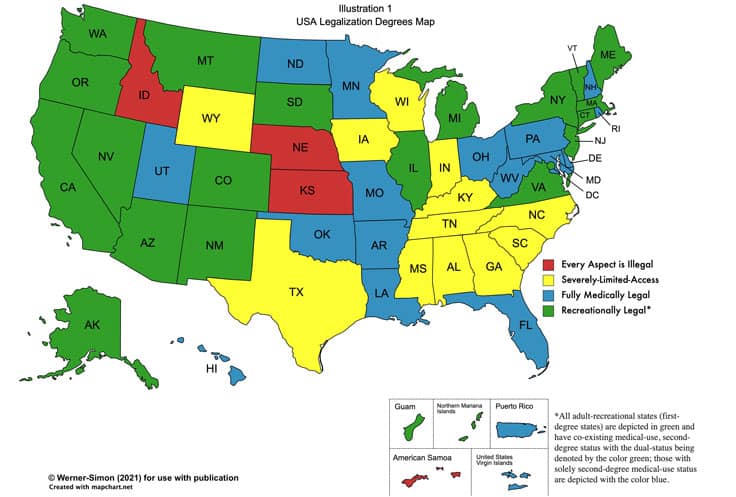There is one cannabis question that is regularly searched across a variety of Internet platforms: How many states have legalized adult recreational use of cannabis as of today? As a cannabis law professor and a legal analyst for emerging cannabis businesses, I often am asked that very question. My response is always the same, no matter the date or the year: “It depends on how legalization is defined.”
State-based cannabis legalization can happen in two ways.
One way is evidenced by those states which permit voters to place topics on the ballot for a vote. The other way is through the legislature, when a state’s assembly writes and passes legalization legislation which is ultimately signed off by that state’s chief executive.
When defined like that, Connecticut became the 19th U.S. state to legalize adult recreational use when, on June 22, 2021, Connecticut governor Ned Lamont signed into law a bill passed by the Connecticut legislature.
This does not mean, however, that Connecticut’s already existing medical cannabis program morphed or expanded into an adult recreational system overnight. Rather, by the terms of the 184 pages of legislative analysis for the law entitled “AN ACT CONCERNING RESPONSIBLE AND EQUITABLE REGULATION OF ADULT-USE CANNABIS,” as of July 1, 2021, possession of small amounts of cannabis would be decriminalized. Also placed in motion, and announced by Connecticut’s administration, regulated adult recreational sales by dispensaries would begin the following year. Connecticut’s new law also has social justice and equity components to include an automatic expungement of drug conviction provision which will commence in the near future.
Six weeks before Connecticut, New Mexico legalized adult recreational use on April 12, when New Mexico’s governor Michelle Lujan Grisham signed into law previously passed recreational legislation. New Mexico’s legislation authorized adult-use retail sales to begin no later than April 1, 2022.
New Mexico’s recreational cannabis legalization occurred five days after Virginia’s successful adoption of adult recreational legalization legislation. Under a law specific to Virginia, when the Virginia legislature adopted their governor’s revisions to their previously passed adult recreational cannabis legislation on April 7, the state effectively “legalized” adult recreational cannabis. Virginia’s governor’s revisions to the legislation also advanced the date when adult-use would begin in the state from January 2024 to July 2021.
Virginia’s legalization was preceded by New York (adult-use state number 16) which legalized on March 31, 2021, when New York’s governor Andrew Cuomo signed legislation (submitted to him by the New York legislature) legalizing adult recreational use.

The South Dakota Issue
But these numbers will fall like dominos and change with those passed this year each reverting back one number depending on what happens in the highest court of South Dakota. That state was one of five that had cannabis initiatives on the ballot in the November 2020 election (the others were Arizona, Mississippi, Montana, and New Jersey).
Every cannabis ballot measure in those states prevailed with gusto. Voters overwhelmingly supported legalizing adult recreational usage in Arizona, New Jersey, and Montana; medical cannabis usage in Mississippi; and both medical and adult recreational use in South Dakota.
But, once the voters made their wishes known, in two of the states, South Dakota and Mississippi, there was a backlash by government officials and the courts.
Some of South Dakota’s elected representatives (including that state’s governor) started a campaign to undermine the will of the voters and invalidate both the medical and adult recreational initiatives passed by a significant majority of South Dakota’s voters. The same thing played out in Mississippi where government officials challenged, in court, the enactment and enforcement of that state’s voters’ legalization plans.
Initially, South Dakota’s governor attempted to block the implementation of the medical program, Measure 26, approved by two-thirds of South Dakota voters. Gov. Kristi Noem issued a statement against cannabis legalization of either sort in South Dakota, asserting that legalization was “the wrong choice” for South Dakota.
But given factors like the brevity of South Dakota’s legislative session, the medical cannabis initiative stuck, and it looks as if medical cannabis in South Dakota will make its debut by year’s end. However, South Dakota officials were more successful in halting adult recreational use.
On February 8, 2021, a South Dakota state court judge ruled against the voters and invalidated South Dakota voters’ passage of an adult recreational cannabis ballot initiative. Recreational legalization proponents appealed the decision to the South Dakota Supreme Court. The highest state court in South Dakota heard oral arguments (for and against) on April 28, 2021.
The parties’ presentations and the justices’ commentary did not give a clear indication of what the high court decision will be. As of publication time, it is not clear how the South Dakota justices will decide.
So, how many states have legalized adult-use cannabis?
Adult Recreational Cannabis Order-of Legalization* in the U.S.
- Colorado (2012)
- Washington (2012)
- Alaska (2014)
- Oregon (2014)
- California (2016)
- Maine (2016)
- Massachusetts (2016)
- Nevada (2016)
- Vermont (2018)
- Michigan (2018)
- Illinois (2019)
- New Jersey (2020)
- Montana (2020)
- Arizona (2020)
- South Dakota (2020)
- New York (March 31, 2021)
- Virginia (April 7, 2021)
- New Mexico (April 12, 2021)
- Connecticut (June 22, 2021)
*Note: Legalization is defined here as happening the day the voters succeed with a majority of votes on an adult recreational legalization ballot initiative, or the day the legislation passes in a state’s legislature or assembly and/or is signed by or adopted (if the time has expired for an executive veto) by a state’s governor. This list of states includes South Dakota, where the issue of adult legalization is being litigated and a decision is expected soon by the South Dakota Supreme Court.
Under the definition of legalization in this article, since South Dakota’s adult recreational program is on appeal but voters in South Dakota approved the initiative, it is more than appropriate that South Dakota remains (precariously) on our voters-have-legalized-adult-rec list.
The “how many states have legalized adult recreational use” question will be decided by the five justices who comprise the South Dakota Supreme Court. It is expected to happen soon as their summer break ends with the beginning of the South Dakota Supreme Court’s September term. If that court tosses the recreational use legalization measure, and South Dakota comes off the adult recreational legalization list, Connecticut will no longer be the 19th adult-use state, it will become the 18th. New Mexico then would follow suit and revert to number 17, Virginia to number 16, and New York to number 15.
To paraphrase British-born poet Elizabeth Barrett Browning, much of the answer to how we should count the number of legalized adult recreational cannabis states depends on the ways in which legalization is defined and what the state courts have to say about the voters’ wishes.
For now, our count is paused.
Julie A. Werner-Simon is a law professor adjunct at Drexel University’s Kline School of Law and an emerging business legal analyst at the LeBow School of Business.
